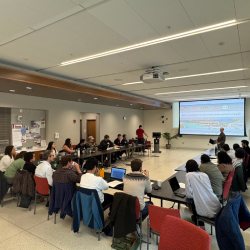BLOOMINGTON, Ind. – Hydropower carries the potential to play a major role in a future low-carbon energy transition, but dealing with some of the challenges presented by the expansion of hydropower will require innovative thinking.
The need for such innovation was the driving force behind the “Rethinking hydropower to satisfy energy, climate, and biodiversity goals” workgroup recently hosted by researchers from the Paul H. O’Neill School of Public and Environmental Affairs. Assistant Professor Rafael M. Almeida, Executive Associate Dean Todd Royer, and Assistant Professor Zhiying Li welcomed colleagues from more than 10 other universities, national labs, non-governmental organizations, and industry to discuss strategies to expand hydropower.
The discussions led to a set of policy-relevant insights on how the use of emerging technologies could help nations expand hydropower generation to support low-carbon electricity grids while minimizing the substantial ecological and social disruptions that hydropower has historically caused to rivers, floodplains, deltas, and the communities that rely on them.
“I am part of a large interdisciplinary working group that brings together academics from universities in the U.S. and abroad focusing on evaluating solutions to minimize the environmental and social impacts of hydropower as nations worldwide work to decarbonize their economies,” Almeida said. “We recognized the importance of convening the whole group to explore innovative approaches for rethinking hydropower development to balance energy, climate, and biodiversity goals.”
Hydropower is the world’s dominant renewable energy source, and additional hydropower facilities are expected to be built globally to support grid stability as variable renewable energy sources like wind and solar continue to grow. Although hydropower may be critical in ensuring a reliable energy supply in certain regions, avoiding the exacerbation of its social and environmental footprint will be key as new projects move forward.
“Much of the future hydropower development is likely to take place in ecologically sensitive river basins in the Global South, where both untapped hydropower potential and biodiversity are high,” Almeida said. “In our working group, we discussed whether scalable and feasible alternatives exist to expand energy generation from hydropower and other water-based technologies without building new dams that could further disrupt global river systems.”
Among the emerging technologies discussed by the group were modernization of aging turbines at existing facilities, adding turbines to non-power dams, deploying floating solar on hydropower reservoirs, building off-channel pumped-storage systems to avoid river impacts, and using AI to optimize operations and integration with other renewables.
The group chose to host its first meeting at the O’Neill School due to its long-standing reputation for producing policy-relevant insights that support sustainability.
“The insights gained from our three-day workshop underscored the significant global potential of these emerging technologies to help countries meet their renewable energy targets while avoiding many of the characteristic environmental and social impacts associated with conventional hydropower dams,” Almeida said. “Our discussions culminated in the development of a draft for a policy-focused essay, which we are now refining and plan to submit to a scientific journal in the near future.”
The initiative is supported by seed funding from Cornell University’s Atkinson Center for Sustainability, supplemented by Cornell’s AI for Science Institute.


